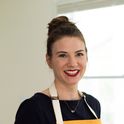For the month of May, our Baking Club is focused on Uri Scheft's Breaking Breads. Members have been churning out dozens of loaves of challah and should they be in need of guidance, they don't have to go far. Uri Scheft himself has joined the club and is answering questions from the group as they come up.
Read on for his tips for baking your best loaf of challah yet and then cast your vote for the Baking Club's upcoming book selections.
Rachel Schowalter: Hi Uri, could you tell me why my challah loaves tore in the middle?
Uri Scheft: Looks like your bread needs to proof longer. By looking at the picture (below), I would say they could have easily needed 30 more minutes. Remember that rise time can change drastically if the dough or the room temperature changes.
If you have your copy of Breaking Breads on hand, turn to page 16 for further explanation.
Paula G. Lefkowitz: I made your challah recipe, it was delicious. My question is why is the dough drier than other challah recipes? Also, why don't we oil the bowl for the first proof?
Uri Scheft: As for the dough, yes, it should be on the semi-harder side—this is how I learned it. This is how I get the challah the right texture, meaning that when I break the baked challah, I've achieved a texture that looks kind of layered (and not too airy and light). The drier dough also shows the beauty of braiding at its best. As for using oil for the bowl, I prefer to use flour, as I do not want to add more oil to the bread and, of course, it's a matter of what I'm used to.
If you’re partial to oiling the bowl, there’s no pressure to switch to flour, Scheft says it’s not that important to the bread.
A few members have noted that the metric measurements and US customary units don't always seem to be exact conversions for ingredients listed in the book—what's a baker to do?
Uri Scheft: My first priority is to use a home weigh-scale and make the recipe by grams: That's how I created the recipes in the book. When we converted grams to cups, tablespoons, etc., we sometimes picked a rounded result.
Bottom line: If you have a scale, use it.
Want to get in on the action and ask Scheft a question yourself? Head here.
Baking Club cookbooks are chosen by you, the participants. To have your say on what cookbooks we'll cover in July, August, and September, fill out this Google Form by Monday, May 22.



See what other Food52 readers are saying.